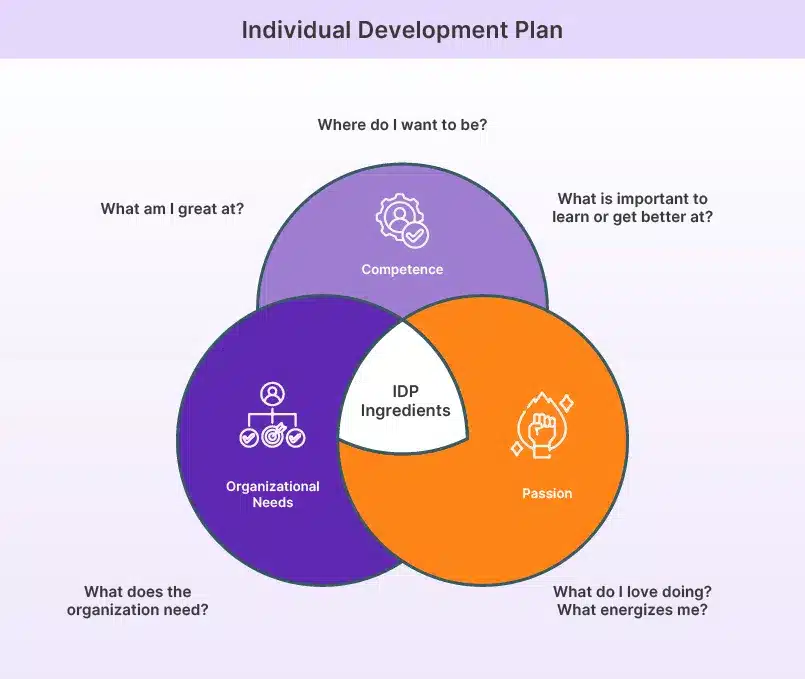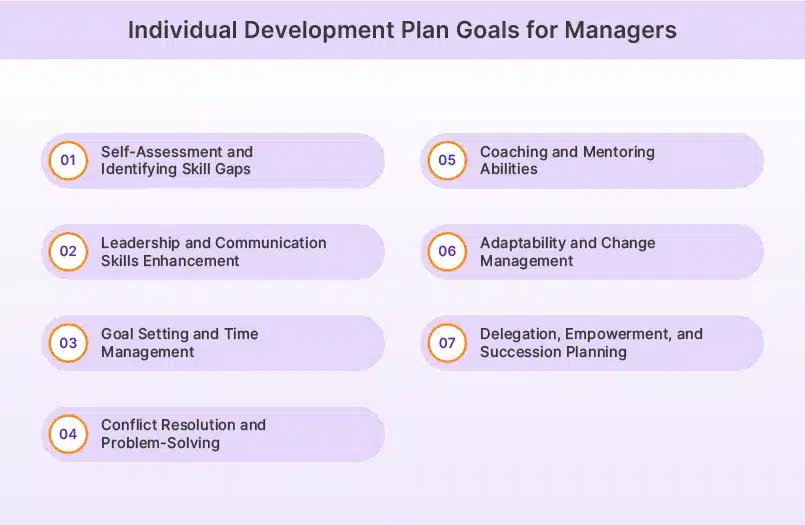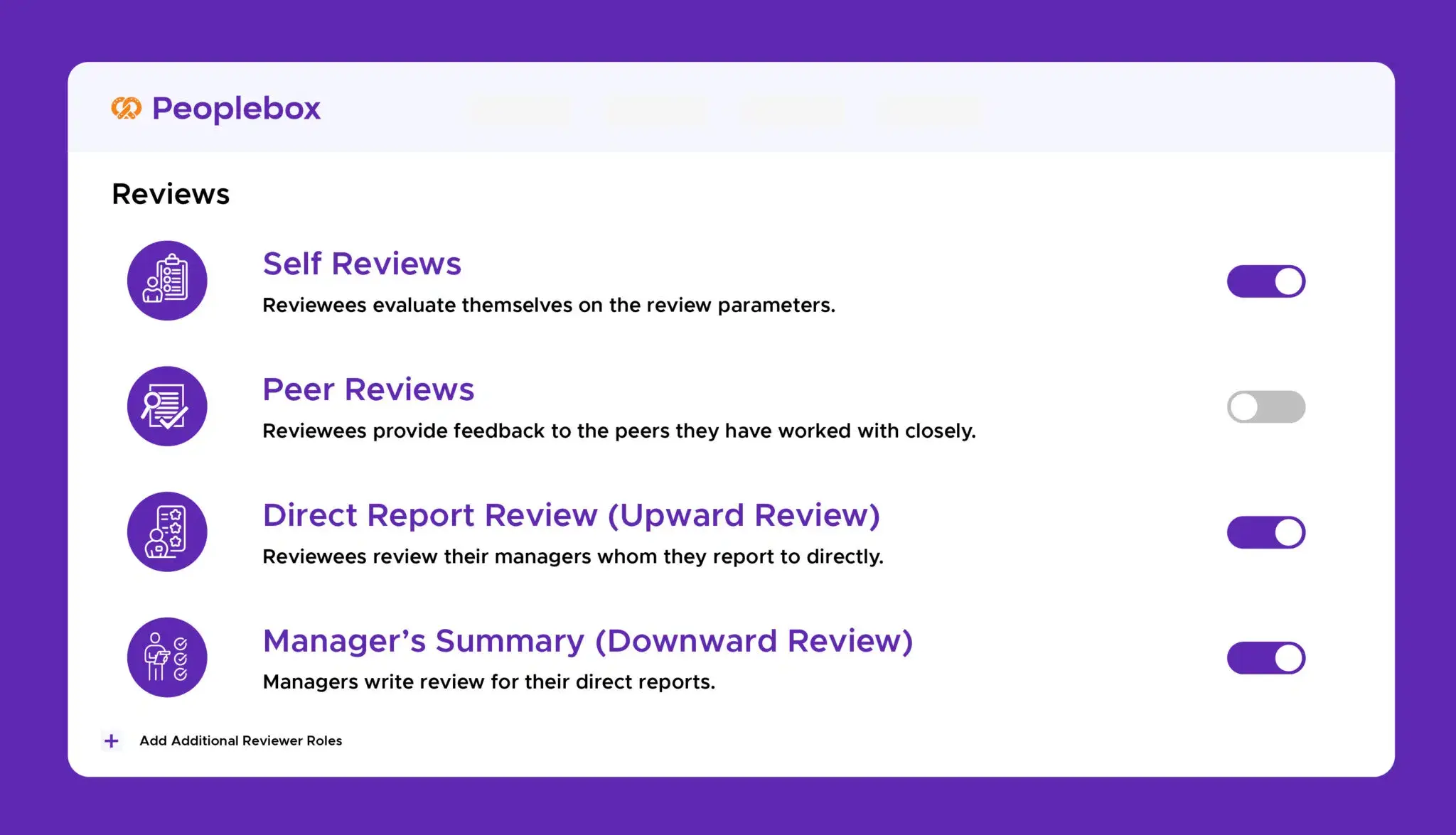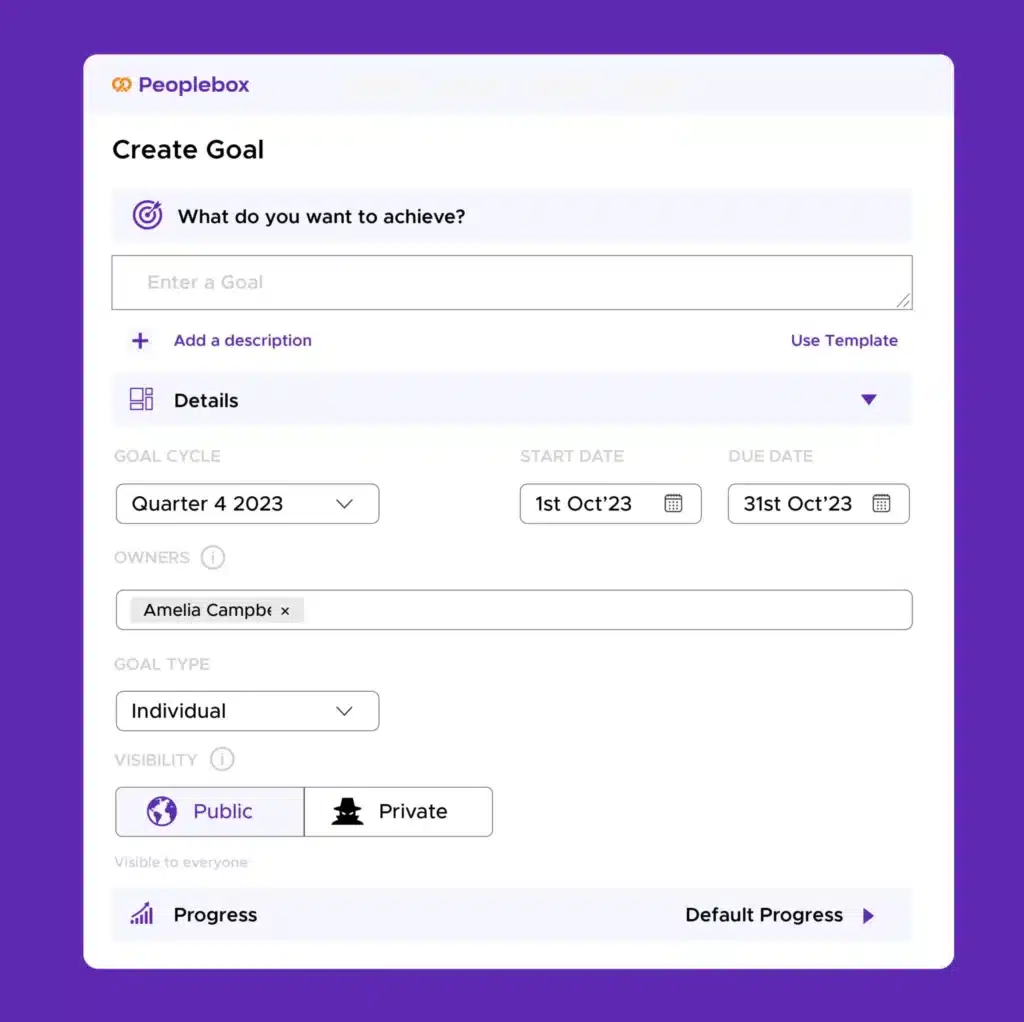Individual Development Plans (IDPs) are a cornerstone of employee growth, but for managers, they offer a unique opportunity to cultivate strong leadership and empower their teams. Recent studies have shown that organizations with effective IDPs for their managers experience a significant boost in productivity and employee engagement.
This blog post explores the specifics of crafting effective IDPs for your managers. It will guide you in setting developmental goals and offer insights on implementing and monitoring effective managerial IDPs.
What is an Individual development Plan?
IDPs are tailored plans that empower managers to enhance skills and leadership, aligning personal growth with organizational goals.
IDPs benefit both managers (career growth) and organizations (better leadership, happier employees).
The individual development goals examples for managers include:
- Self-assessment and skill gaps
- Leadership and communication
- Goal setting and time management
- Conflict resolution and problem-solving
- Coaching and mentoring
- Adaptability and change management
- Delegation and succession planning
Also read: HR’s guide to employee development
The best practices for implementing and monitoring IDP goals for managers are:
- Collaborative approach with HR and higher management.
- Regular progress assessments and feedback loops.
- Overcoming challenges like workload management and resistance to learning.
We also cover the challenges you might face and the strategies to overcome them:
- Constraints and Workload Management: Prioritizing development and seeking support from HR.
- Resistance to Change and Learning: Fostering a growth mindset and seeking learning opportunities.
- Lack of Resources for Skill Development: Exploring alternative learning opportunities.
- Lack of Clarity in Setting Goals: Breaking down larger aspirations into smaller steps and seeking feedback.
Upgrade managerial potential with Peoplebox for a seamless and effective IDP process. Book a demo today!
What are Individual Development Plans for Managers?

Unlike regular performance evaluations that focus on short-term performance, IDPs extend beyond the scope of reviews and concentrate on long-term career aspirations and skill enhancement. This forward-thinking approach empowers managers to take charge of their professional development and align their growth with the organization’s strategic objectives.
According to McKinsey, organizations that actively support employee development experience higher retention rates and are more likely to attract top talent.
By adopting IDPs, managers gain the tools and insights to nurture the potential of their team members effectively.
The IDP process encourages managers to develop coaching and mentoring abilities, fostering a supportive and growth-oriented team environment. This not only enhances employee performance but also contributes to the overall productivity and success of the organization.
Individual Development Plan Goals for Managers
Setting individual development plan goals for managers is a pivotal step in their professional growth journey. These goals are the building blocks for enhancing managerial skills, fostering leadership qualities, and driving overall team success.

Let’s dive into the key individual development plan goals.
🎯 Self-Assessment and Identifying Skill Gaps
Self-awareness is the foundation for a successful IDP. By conducting thorough self-assessments, managers can identify areas for improvement and skill gaps that might hinder their success.
Addressing these gaps through targeted development plans, such as attending workshops or training sessions, can enhance their capabilities and transform them into more effective leaders.
👉 Individual Development Goals Examples for Self-Assessment
1. Complete a 360-degree Feedback Survey: Gain insights from peers, subordinates, and superiors to identify strengths and areas for improvement.
2. Take a Leadership Skills Inventory: Use assessments like the Myers-Briggs Type Indicator (MBTI) or DiSC to understand personal leadership styles and competencies.
3. Attend a Self-Assessment Workshop: Participate in workshops that focus on personal and professional growth and provide tools for self-evaluation.
4. Set Up Regular One-on-One with a Mentor: Schedule monthly meetings with a mentor to discuss performance and identify skill gaps.
5. Create a Personal SWOT Analysis: List personal strengths, weaknesses, opportunities, and threats to formulate a targeted development plan.
🎯 Leadership and Communication Skills Enhancement
Strong leadership and communication skills are game-changers for business managers. With enhanced leadership qualities, they can inspire and motivate their teams to achieve remarkable results.
Effective communication skills enable them to build better relationships with clients and stakeholders, leading to improved collaboration and successful business deals.
👉 Individual Development Goals Examples for Communication Skills Enhancement
1. Enroll in a Leadership Development Program: Participate in programs offered by institutions like Harvard Business School or Wharton to enhance leadership skills.
2. Join a Toastmasters Club: Improve public speaking and communication skills by actively participating in a local Toastmasters chapter.
3. Attend Conflict Resolution Workshops: Learn advanced techniques for managing and resolving conflicts through specialized training sessions.
4. Read Leadership Books: Commit to reading one leadership book monthly, such as “Leaders Eat Last” by Simon Sinek or “Dare to Lead” by Brené Brown.
5. Practice Active Listening: Incorporate active listening exercises into daily interactions to improve communication and build stronger relationships.
Suggested See: 67 Lominger Competencies in Leadership Development
Lominger Competencies are a set of 67 leadership and behavioral competencies developed by Michael Lombardo and Robert Eichinger. These competencies provide a comprehensive framework for identifying and developing key skills and behaviors necessary for effective leadership, enhancing talent management, and driving organizational success.
🎯 Goal Setting and Time Management
Setting clear OKRs and achievable goals is instrumental in driving success. Using a goal-setting platform can streamline the process, helping them align their objectives with the organization’s and track progress efficiently.
Effective time management ensures managers prioritize tasks, leading to better productivity and timely project execution, ultimately elevating business performance.
Managers can learn to set OKRs with the best OKRs and strategy execution software, like Peoplebox. They can build a truly goal-driven and time-management culture to accelerate their business growth.
👉 Individual Development Goals Examples for Goal Setting and Time Management
1. Use a Goal-Setting Platform: Implement software like Peoplebox to set and track OKRs (Objectives and Key Results) aligned with organizational goals.
2. Take a Time Management Course: Enroll in courses offered by platforms like Coursera or LinkedIn Learning to master time management techniques.
3. Create a Daily Task List: Develop a habit of listing daily tasks and prioritizing them to ensure the most important tasks are completed first.
4. Implement the Pomodoro Technique: Use this time management method to improve focus and productivity by breaking work into intervals with short breaks.
5. Set Quarterly Performance Goals: Define and review quarterly goals to ensure continuous progress and alignment with long-term objectives.
🎯 Conflict Resolution and Problem-Solving
Conflict resolution and problem-solving skills are game-changers in handling challenging situations.
For managers, navigating conflicts with clients or team members effectively can preserve relationships and strengthen partnerships. Additionally, adept problem-solving skills enable them to overcome obstacles swiftly, ensuring smooth project delivery and enhancing the organization’s reputation.
👉 Individual Development Goals Examples for Conflict Resolution and Problem-Solving
1. Attend Mediation Training: Gain skills in mediation and conflict resolution through specialized training programs.
2. Participate in Problem-Solving Workshops: Enhance problem-solving abilities by attending workshops focused on critical thinking and creative solutions.
3. Conduct Role-Playing Exercises: Practice conflict resolution scenarios with team members to improve the real-world application of skills.
4. Read Books on Negotiation: Study negotiation techniques by reading books like “Getting to Yes” by Roger Fisher and William Ury.
5. Join a Peer Support Group: Collaborate with other managers to share experiences and strategies for handling conflicts and solving problems.
🎯 Coaching and Mentoring Abilities
Investing in coaching and mentoring team members transforms managers into an exceptional leader.
By guiding their team’s growth and professional development, they foster a culture of continuous improvement and employee engagement. This approach can significantly impact team performance, leading to higher levels of productivity and innovation.
👉 Individual Development Goals Examples for Coaching and Mentoring Abilities
1. Take a Coaching Certification Course: Become a certified coach through programs like those offered by the International Coach Federation (ICF).
2. Host Regular Team Workshops: Organize workshops for team members to foster professional development and continuous learning.
3. Implement a Mentorship Program: Establish a formal mentorship program within the organization to guide the growth of junior employees.
4. Attend Coaching Seminars: Participate in seminars that focus on developing coaching techniques and methodologies.
5. Read Coaching Literature: Enhance coaching skills by reading books such as “The Coaching Habit” by Michael Bungay Stanier and “Coaching for Performance” by John Whitmore.
🎯 Adaptability and Change Management
If managers embrace change and adjust their strategies quickly, they can seize new opportunities and stay ahead of the competition. Their adeptness in change management ensures smoother transitions during organizational shifts, minimizing disruptions and maximizing productivity.
👉 Individual Development Goals Examples for Adaptability and Change Management
1. Attend Change Management Training: Enroll in training programs such as those offered by Prosci or Kotter International to learn effective change management strategies.
2. Participate in Agile Methodology Workshops: Learn agile principles and practices to enhance flexibility and responsiveness in managing projects.
3. Implement Continuous Learning: Commit to lifelong learning by regularly attending webinars, seminars, and courses on industry trends and innovations.
4. Practice Mindfulness and Stress Management: Engage in mindfulness exercises and stress management techniques to remain calm and adaptable in the face of change.
5. Lead Change Initiatives: Take the lead on a change initiative within the organization to gain hands-on experience in managing transitions.
🎯 Delegation, Empowerment, and Succession Planning
Skillful delegation and empowerment empower managers to focus on strategic initiatives while building a capable and autonomous team. Effective succession planning ensures a seamless leadership transition, safeguarding the organization’s future.
Managers who excel in these areas create a resilient and agile workforce that can respond to challenges and drive long-term success.
In general, collaboration between managers, HR, and higher management is crucial to implement and monitor IDPs effectively. This allows managers to track their development and make necessary adjustments.
Also read: Best Succession Planning Tools in 2024
👉 Individual Development Goals Examples for Delegation, Empowerment, and Succession Planning
1. Attend Delegation Skills Training: Participate in workshops that focus on effective delegation techniques and strategies.
2. Create a Succession Plan: Develop and document a formal succession plan for key positions within the team or organization.
3. Empower Team Members: Identify and delegate responsibilities to team members, providing them with the necessary resources and authority to succeed.
4. Mentor Potential Successors: Actively mentor and develop potential successors, offering guidance and opportunities for growth.
5. Set Up a Leadership Development Program: Establish a program within the organization to identify and cultivate future leaders, ensuring a pipeline of capable managers.
These goals, when set thoughtfully and pursued diligently, can significantly enhance a manager’s effectiveness and contribute to their professional growth. Incorporating a variety of learning and development methods ensures a comprehensive approach to skill enhancement and leadership development.
▶️ Implementation and Monitoring of Managerial IDPs
Once managers have established their individual development goals, it is essential to have a well-structured approach to implement and track their progress.
Let’s look at how you can implement individual development goals at your organization.
1. Collaborative Approach with HR and Higher Management
A successful implementation of managerial IDPs requires a collaborative approach with HR and higher management. Managers should actively involve HR professionals in the creation and implementation of IDPs.
HR’s expertise can help tailor IDPs to meet individual managerial needs while ensuring they align with the organization’s overall objectives. This collaborative effort ensures that IDPs are well-integrated with the organization’s strategic priorities, contributing to long-term success.
When higher management is committed to managerial development, it sends a powerful message about the organization’s investment in its leaders’ growth. Support from higher management equips you with the necessary resources and opportunities to succeed in their development journey.
2. Regular Progress Assessments and Feedback
Regular progress assessments are mandatory to monitor the effectiveness of managerial IDPs. They should conduct periodic reviews to track their development progress against set goals.
These assessments help identify areas of improvement, reinforce successes, and keep IDPs on track. By measuring progress over time, they can gauge the impact of their efforts and make data-driven decisions.
Gathering feedback from peers, subordinates, and superiors adds valuable insights to the assessment process. Feedback from different perspectives provides a holistic view of a manager’s performance and development. It allows them to understand their strengths, identify blind spots, and uncover opportunities for growth.
With Peoplebox’s 360 degree feedback platform, you can get a complete picture of an employee’s performance in a single place.

Based on performance evaluations and feedback, they can make necessary adjustments to their IDPs. Flexibility in the development process enables managers to respond to changing circumstances and refine their goals as needed. They can use goal tracker apps that will help them with creating and tracking individual development goals.
By continuously improving and adapting their IDPs, they can ensure you remain on the path of growth and achieve long-term success.
OKR management platforms like Peoplebox let you create goals in a few clicks!

💪 Overcoming Challenges in Managerial Individual Development Plan
Challenges are inevitable in any development process, including managerial IDPs.
To ensure successful implementation, managers must know potential obstacles and strategies to overcome them.
❌ Constraints and Workload Management
Managers’ days are often filled with various responsibilities and tasks, leaving limited time for their IDP. To address this challenge, managers can—
👉 Prioritize their development by allocating specific time each week for IDP activities.
👉 Leverage performance management software to help streamline their time and workload while staying focused on their development goals.
👉 Delegate non-essential tasks to their team members and seek support from HR.
By involving their team in the process, they can collectively find solutions to manage their workload and create a supportive environment for their development.
❌ Resistance to Change and Learning
Change can be met with resistance, and managers may hesitate to embrace new development initiatives. They can overcome this challenge by fostering a growth mindset and recognizing that continuous learning is essential for their leadership growth. They can –
👉 Look out for training programs and resources aligned with their goals and interests.
👉 Engage in conversations with mentors or peers who can provide support and guidance.
By actively seeking learning opportunities and embracing change, they can accelerate their development.
❌ Lack of Resources for Skill Development
In some cases, access to formal training programs or resources may be limited due to budget constraints or other factors.
To address this challenge, managers need to be resourceful and explore alternative learning opportunities. They should –
👉 Look for free or affordable online courses, webinars, or workshops that cater to their needs.
👉 Tap into their professional network for mentorship or skill-sharing opportunities.
By leveraging their connections and seeking digital resources, they can continue their development journey without depending solely on formal training programs.
❌ Lack of Clarity in Setting Goals
Setting meaningful and achievable goals is crucial for the success of your IDP. If managers find it challenging to define clear objectives, take a problem-solving approach. They can –
👉 Break down their larger aspirations into smaller, actionable steps.
👉 Consult with their team or supervisor to align their goals with organizational objectives.
👉 Ask for feedback and guidance to refine their goals and ensure they are realistic and relevant to your career progression.
By taking a proactive problem-solving approach and leveraging strategy execution software like Peoplebox, managers can overcome challenges in their IDP and create a roadmap for their success.
Remember, a growth journey is unique, and with the right strategies and resources, managers can achieve their personal and professional aspirations.
🥨 Fuel Your Individual Development Plan Goals with Peoplebox
Building a strong and sustainable future requires investing in skill enhancement through IDPs. To make this process seamless, consider leveraging Peoplebox, the best strategy execution software designed keeping your managers and leadership in mind. With its user-friendly interface and comprehensive features, your managers can:
✅ Connect with their goals
✅ Ask for feedback
✅ Immerse themselves with the best OKR coaching
✅ Seek employee reviews
That’s not all. Through talent assessment, they can also gain valuable insights into their strengths and areas for development and strategize their goals accordingly.
What are you waiting for? Take the first step towards success – get started with Peoplebox today!







